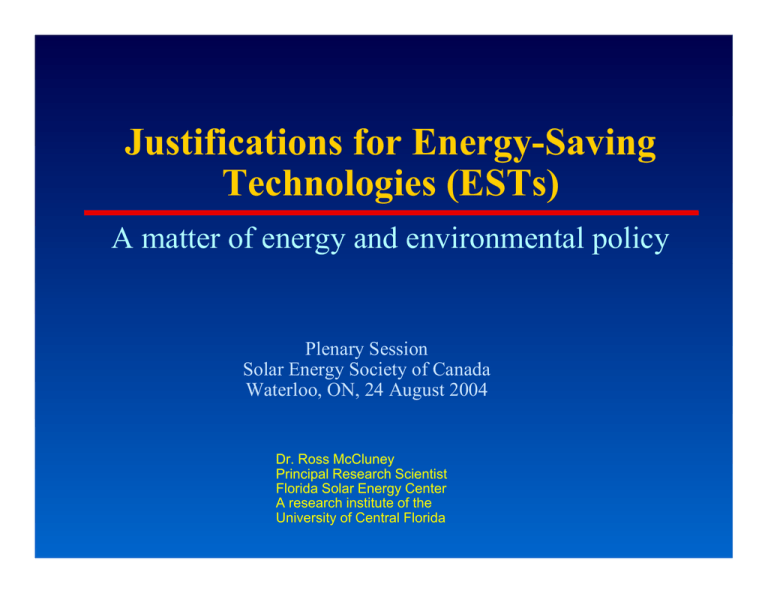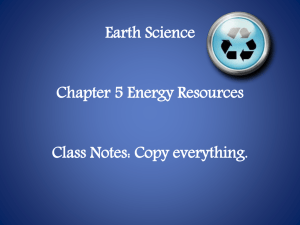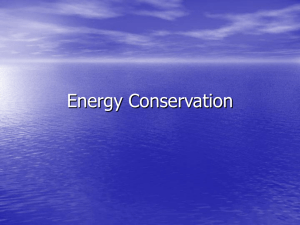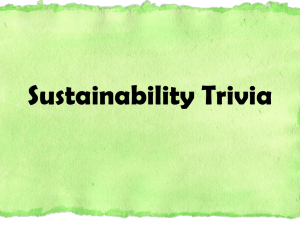Justifications for Energy-Saving Technologies (ESTs) A matter of energy and environmental policy
advertisement

Justifications for Energy-Saving Technologies (ESTs) A matter of energy and environmental policy Plenary Session Solar Energy Society of Canada Waterloo, ON, 24 August 2004 Dr. Ross McCluney Principal Research Scientist Florida Solar Energy Center A research institute of the University of Central Florida Energy Efficient Technology Compact Fluorescent Lamps P Produce same light output as an illumination-equivalent tungsten filament lamp < At less energy cost < Less heat for the same light output, saving on air conditioning costs < Great energy savers, and they even last a lot longer! < But they cost more < This inhibits more widespread use. Lamps to produce 900 Lumens Light Output Incandescent Compact fluorescent Fluorescent Incandescent Power Consumption,W Luminous efficacy, Lm/W Power Consumption,W Luminous efficacy, Lm/W 60 15 15 60 Renewable Energy Technology Windmills, for example P Source is not depletable, for several hundred thousand years P Much less polluting P Contribute much less to global warming. P Exception: renewable biomass systems based on combustion P Caveat: using a renewable resource at a rate faster than it is replenished is not sustainable So How Do We Value These Technologies? To most, it’s just a matter of economics. We decide to use them only if the economic indicators are good. Traditional Energy Accounting Begins with Costs and Savings P Let C be the total of the extra costs P Let S be the savings, the reduced energy cost attributable to the extra features over the year or the value of the energy produced by renewable energy systems Payback Time P Simple Payback Time SPT = C/S P C is in $ and S is in $/yr P So SPT is in years P SPT is the time it takes for < dollar savings = extra costs of the energy-saving measures < assuming no change in energy prices over the years. P Effective payback time or discounted payback time, accounts for changes in the price of energy P As energy prices increase, dollar savings do as well, and the payback time shortens. Return on Investment (ROI) P ROI: ratio of the savings S per year to investment C, as a percent: ROI = 100% (S/C) P ROI is 1/PBT times 100% P Example: 4 year payback time = 25% ROI P The shorter the payback time, the greater the return on the investment P There is a variety of additional economic indicators < Cash flow analysis < Life-cycle costs < Net energy analysis Many ESTs have good performance by these measures...but still are not widely enough used. P Least-initial-cost is still a powerful driver P Low energy prices lengthen payback times P Energy codes work, but only minimally, because they aren’t strict enough. — “Designing down” P Markets often fail to see the bigger picture, until rather late in the game < especially if they are biased in the wrong direction by certain government policies (such as subsidizing fossil energy). P The main purpose of this talk is to examine the bigger picture, always trying to answer the “why” questions. Why don’t EST’s sell better? P Higher initial cost — a powerful disincentive P Momentum — business as usual, fear of “risk” taking. P Time and money limits inhibit designers from taking the extra time and effort P Historically — Cheap fossil fuels and cheap inefficient technology provide little incentive P Lack of easy-to-use mechanisms for calculating energy savings and employing life-cycle costing routinely P Non-monetary benefits are difficult to quantify, especially in consumer markets < It is difficult to make prices reflect these benefits Non-monetary Benefits are Insufficiently Considered P Both commerce and government have difficulty making prices reflect important societal benefits. P Left out: < Human factors, positive and negative < Dollar values of improved worker health and productivity < Wider economy of nature – We’re spending our capital < Other life forms on Earth < General ecosystem health < Future energy prospects P Let’s look at our energy future Future Energy Begins with the past Exponential growth of world oil and coal production Coal and oil What do you think happened in the next 40 years? 40 yrs Coal 40 yrs 1820 1840 1860 1880 1900 1920 1940 1960 1980 2000 And what will happen 40 years after that? M. King Hubbert, “The Energy Resources of the Earth,” Scientific American, September 1971, pp. 60-70. The Future of Oil Production Half gone C. J. Campbell and J. H. Laherrere, “The End of Cheap Oil,” Scientific American, March 1998, pp. 78-83. The Peaking of U.S. Oil Production A massive failure of government policy P The U. S. peaked its production of oil in 1972. P Then we turned to other countries to make up the shortfall. P We had a very unique opportunity in 1972 P To initiate a crash program to convert to energy conservation and renewable energy sources, becoming energy self-sufficient. P We missed that opportunity. P And now we import more oil than any other nation on earth. P When will world oil production reach its peak? The Peaking and Decline of World Oil 1998 Projection by Campbell and Laherrere U. S. production peaked in 1972, only 3 years after 1969, the year Hubbert predicted (in 1956) it would happen. C. J. Campbell and J. H. Laherrere, “The End of Cheap Oil,” Scientific American, March 1998, pp. 78-83. U. S.+ Canada peak World peak Canada’s Peak Oil 2001 World Oil Depletion Estimate World Production Modeled on an ultimate 2000 Gb 40 Saved oil success story 30 20 10 Today 0 1930 1950 1970 1990 2010 2030 2050 Missed U.S. opportunity Actual & Forecast Theoretical Source: C. J. Campbell, “The Oil Peak, a Turning Point,” Solar Today, July/August 2001, p. 41. Later estimates of the date of peak world oil production P “Before 2004.”, made by Deffeyes in 2001, Hubbert’s Peak, p. 12. P “We may have already passed it.” made by Campbell in 2002, private communication. It’s not like we haven’t been warned Discussions about “Peak oil” are all over the internet Looking at All the Fossil Fuels 300 Epoch of the fossil fuels 200 100 0 -5 -4 -3 -2 0 -1 +1 Time before and after present (103 years) +2 +3 +4 “Like the flame of a candle in the long dark night” “The epoch of the fossil fuels ... is responsible for the development of our modern industrial civilization....” M. King Hubbert, “The World’s Evolving Energy System,” Am. J. Phys., Vol. 49, No. 11, Nov. 1981, p. 1026. +5 Exponential Growth in Nature Can Be Dramatic, But is Only Temporary The recent exponential growth in population was accompanied by an exponential growth in use of fossil fuels. As we pass the peak of fossil fuels..... UN World Population Projections 14 Constant 12 High 10 Medium 8 Low 6 The death solution ? The projection uses four assumptions about average future fertility rates. The “constant” rate is the fertility in the year 2000. With modest effort, some believe that the “High” rate is possible, a doubling to 11 billion by the middle of the century. 4 2 0 1960 1980 2000 Year 2020 2040 To achieve the “medium” rate will require considerable extra effort toward family planning and birth control around the world. In spite of our continued growth We Are NOT Running Out of Oil P There will be no precipitous collapse. Total oil endowment is about 2200 Gb. We’ve used nearly 1000 Gb of it. P We may never “run out” P Just a slow decline in supply with rising prices P New oil will be more remote, more difficult to extract, and more costly to produce P Petroleum prices can only increase—indefinitely (on average) Other Fossil Fuels Assessment P World endowment totals: P 2700 Gb of liquid fuel, 1850 is regular oil < USGS says 2000 to 2200. Probably won’t exceed 2500 Gb total < We’ve used about 950 Gb of regular oil, 45% P Natural gas world endowment: < 1680 Gb oil equiv, 23% produced as of 1996 P Coal world reserves 1999: < 984 billion tonnes, being used at 4.4 billon tonnes/yr (thus lasting 223 yrs, but at growing rates, we’ll run out much sooner than this) P But consider what we need the oil for K Human Uses of Petroleum # Fuel # Plastics # Textiles # Pharmaceuticals # Fertilizer # Pesticides & herbicides # Chemical industry feedstocks # If these cost a lot more, what will happen to economic growth? Conjectures on Possible Future Consequences of Declining World Oil Production P Transportation fuel prices will increase P Prices for commodities being transported will increase P Electricity and fuel oil prices will increase, along with the prices of the foods most heavily dependent upon fossil fuel P There will be a rush to conserve petroleum for more durable uses P A push to relocate places of work closer to homes and vice versa P Food prices will increase and we’ll be pressured to consume less meat. P What is the fossil fuel subsidy to the U.S. food production system? The answer: L We’re Eating Oil, Not Solar Energy 20 Distant fishing 10 Feed lot beef Fish protein concentrate 1970 1950 5 Grass-fed beef 1960 1940 Intensive eggs 1930 2 Coastal fishing 1910 0.2 Grass-fed cows Low-intensity eggs Range-fed beef Low intensity Corn Modern milk 1920 1.0 0.5 Ten to one Intensive potatoes One to one Intensive corn Soybeans Intensive rice Hunting and gathering 0.1 Low intensity potatoes 0.05 Burma Shifting agriculture 0.02 Thailand China Indonesia Source: Steinhart and Steinhart (1974). The Fires of Culture: Energy Yesterday and Tomorrow. Wadsworth Publishing. Consequences of Declining Oil — continued P Increasing pressure on the industrialized nations to use less < To leave more for developing nations to consume as they develop P How long until this starts happening? < Middle of this decade P How long do good energy efficiency and renewable measures last? < Many decades P So how fast do we need to convert to energy conservation and renewables? My Advice to Purchasers P Never mind energy codes, utility incentives, and other requirements. P Purchase THE most energy efficient technology you can afford < Insulation, windows, A/C, automobile, truck, TV, airplane, factory machinery, lighting, computer, pool pump, etc. P Purchase THE best renewable energy system you can afford < Solar water heater, solar space heater, solar power station P Get off the grid! < Note: DOE Zero Energy Buildings program < Not just because it’s the right thing to do, but for protection against future oil price shocks. The Obvious(?) Policy Conclusion Shouldn’t we drastically curtail our use of oil? P In a truly free market economy, we could just let oil prices rise naturally. P Or we could force them to rise. P But the consuming public will hear none of it. They want their energy when they want it, and at cheap prices... ...forever. The media seem to agree. P And least-first-cost is still too powerful a market driver. A Counter Argument Many people have proposed various alternative scenarios P Amory Lovins suggests that radical resource efficiency will dominate the market for energy-consuming systems. < It will happen faster than the decline in world oil production. < There will be no crisis as we run out of oil. < Energy efficiency and substitute fuels will rule the day, allowing us to keep up with declining supply. P Suggested substitutes include < liquid fuel from renewable biomass such as corn < hydrogen derived from solar-powered electrolysis of water < Heavy use of other renewable sources. Optimists Like This Say P It is true that world population growth will continue, (ultimately capping out at 15-20 billion). P And growth will continue in the per capita use of energy, especially in the developing countries. P But radically increased energy efficiency will save the day. Along with increased use of renewables. P This will occur on a massive scale. P It will be enough to keep ahead of growing demand. My Response P The world cannot handle another doubling of human population. P Some renewable energy systems may not pan out: < Technological problems < Cost problems (Poor people can’t afford.) (They may not use much energy but are working hard to use more.) < Limited resource availability < Adverse environmental consequences < (Solar is not a panacea) P Public policy currently fails to offer strong enough incentives for energy efficiency or renewable sources. P China, India, Africa, and South America are growing and demanding more energy-consuming technologies P New energy demand can outstrip improved energy efficiency and more use of renewables. P The base of existing energy-consuming systems can’t become efficient overnight. And World Demand Keeps Growing Its population growth too! Simmons & Company, International --- Investment Bankers to the Energy Industry “Who will fuel China?” Thomas E. Drennen, John D. Erickson, Science, Vol. 279, 6 March 1998 P In the 1990s China’s GDP grew an average of over 11% each year. P To fuel this growth, in 1993 China became a net importer of oil. P China’s fossil fuel consumption dominates the politics of global environmental change as well. P Chinese oil imports are growing. They could reach 7-8 million barrels per day by 2015 and 13-15 million by 2025. P With the coming declines in oil production, China’s growing need poses a serious threat to future global energy security. Thomas E. Drennen, John D. Erickson, Science, Vol. 279, 6 March 1998 In Light of This P Shouldn’t we buy the most energy-efficient technology and install the best renewable resource available? P The reality: we continue purchasing what is costeffective in only a narrow monetary sense. P When energy prices are low, more energy consumption results, not less. P So vendors have trouble stocking and selling better products. P There is an inherent conflict between what the “free market” wants and what is needed to achieve sustainability. P Our failures to anticipate future pressures and respond ahead of time can be devastating. It’s way past time to wake up to the realities. And if you thought the energy situation was bad, look at water P More and more people demand more water. P And more food. P So more water is needed, for us and for our food. P We pump more water, mostly using fossil fuels P As temperatures go up, water tables go down. P The water shortage threatens to be more urgent even than the growing oil shortage Freshwater shortages are now commonplace around the globe National Geographic Magazine Our problems are much worse than just crises with energy & water P Global warming, stratospheric ozone depletion, air pollution, water pollution, soil depletion chemicalization and pollution, habitat destruction, fisheries depletion, species extinction. P We can only conclude: P Humanity is systematically taking apart the life-support system of planet Earth P Daniel Quinn & Alan Thornhill: We are systematically replacing nonhuman biomass with human biomass P These strong statements perhaps deserve some elaboration Human Impacts P As we add people, they need more food. P To get that food we need more agricultural land. P So we convert biologically diverse areas into crop monocultures, and cities with people. P The consequence is that we are extincting 20 species a day on average. P E. O. Wilson: This, the sixth great extinction event, is human induced, and we may be one of the species that falls victim. P We’ve barely started remedial action. The Circular Chain of Inaction Homeowner Retailer Educator Knowledge and Motivation Vacuum Wholesaler Legislator Builder Designer News media Regulator “A chicken and egg problem in a dog eat dog world.” Though it is tempting to work on one link in the chain, all must be addressed. How did we come to this? P Failures of understanding, of education, of leadership, of investigative journalism, and of individual judgment and responsibility. P All of these can keep us from moving to radical resource efficiency..... with terrible consequences. P To understand how we came to this point, P And why we go on doing it... P Requires a fresh look at our history P A larger view of who we are and how we got to this place. Part 2 We begin at the beginning Historical Marker Evolution of the Universe – Our Planetary Geneology “We are connected” Planets, life forms, coming (and going) -16 -14 -12 -10 -8 -6 Time in billions of years -4 -2 -5 billion The Apollo image The recent Hubble Space Telescope image 0 Evolution of the Earth — Our Species Geneology -5 -4 -3 -2 -1 Time in billions of years Coal: 250-350 million years Oil: 150 million years old 0 Year 2000 From one-cell to multiple cells. From plants to animals. Multicellular animals Vertebrates Dinosaurs -3 million yrs Life begins Earth formed Historical Earth Events Earth History 3 Million Years Ago: Earth fully formed, ready for Humanity Human History op 10 ,0 0 0 6.0 F ir st hu ma ns -P 4.0 2.0 6 B illion people Y ear 2000 Oil deposits essentially complete, waiting to be discovered lio n m il 0 8 0 0 1 8 0 l l io n ar m i 00 Ye 5 0 on E 50 ar 1 il li C Ye m B 0 0 :1 5 0 op 3 P ear Y World Population in Billions H um an H istory The single most remarkable feature on this graph 125,000 hum ans 1 m illion yrs. ago 10, 000 BC E 0.0 -3.0 -2.5 -2.0 -1.5 -1.0 -0.5 Tim e in m illions of years Sustainable hunting and gathering period 0.0 0.5 Civilization History History of Civilization Ag ric 4.0 2.0 6 Billion people Year 2000 ye ar 19 70 2. 5 ye b ar illio 19 n 80 50 ye 0 m ar il 18 lion 00 50 ye 0 m i ar llio 15 n 00 ultu re 6.0 First major change in human energy use le op pe CE on 0 B illi 0 m : 35 10 ar Ye World Population in Billions (Oil is still being generated, but at the same very slow rate) 0.0 -10 -8 -6 -4 -2 0 Time in thousands of years BCE 2 Agriculture P The most amazing and powerful solar collection, storage, and distribution system the world has ever known P We became able to eat more, live better, and have more control over our lives P We domesticated animals, giving us more concentrated energy P And we learned how to grow more people P Population started growing faster Our appetite for energy has become insatiable P First through agriculture P Then through burning wood P Then through increasing use of the fossil fuels. P This growth has paralleled an amazing growth in human population. P When the fossil energy is withdrawn, what will happen to population? Following the invention of agriculture P People stayed in one place, built houses and cities P Gained a sense of control over nature P Dominance grew: people over people and people over the Earth P We lost our closeness with nature P We were on a continual quest for improvement of life G The Invention of Agriculture Was the Most Significant Turning Point in All Human History Increasing energy use 3,000,000 B.C. LEAVERS 8,000 B.C. 2,000 A.D. From Ishmael by Daniel Quinn, 1992 Also described in The Emergence of Society by John Pfeiffer, 1977 Leaver Culture Taker Culture The Good Part: Great works of art, music, sculpture, architecture, dance, science But there are problems with the way we’ve achieved our “better” lives P We’ve become more separated from nature — from the real world, both physically and philosophically. P Now we learn about nature not from the real thing but from books, television, and computers. P Our technology separates us from the environmental consequences of our actions. Out of sight--out of mind. P We have set aside (or ignored) nature’s natural feedback mechanisms. P We’ve become overly dependent on Nature’s old black blood—oil—to make things possible. P The very paradigm by which we live and plan and “advance” has come into question. P We’ve been forced to a new realization. The great discoveries of science P Earth is primary. Humanity is derivative. P Earth is self-propagating, in the sense that life forms come forth and multiply, but not beyond what is sustainable. P Those which work in the system continue. P Any species that doesn’t fit, doesn’t work within the overall system, gets kicked out and doesn’t continue. P Humanity has broken away from many former constraints, temporarily, and has overwhelmed all other life communities. P The Earth is left with a species that is out of control, overwhelming all others. P Any true “solution” must recognize these facts and address the truly underlying problems, and Earth’s principles of operation. Some Conclusions P Recommendations for recycling and energy conservation are little more than incremental, patchwork, ineffective, do-goodisms — when they are not part of a larger effort at more general system reform. P For true and lasting reform to be possible, for our struggle toward sustainability to be less of a struggle against powerful opposing forces, we need a major conceptual shift — a new worldview. P Once we have this, it all will become so much easier. P In the meantime, Earth re-education is essential. P And strong government measures to push the transformation much faster, if only as a stop-gap to give us time for more substantive reform. The Good News No one likes negative motivating forces P Unfortunately, negative motivating forces are in abundance. They are what we have. P There are many positive ones too. P Energy efficient buildings are more comfortable and work is more pleasant in them. P We can feel good about doing good. P Life can be simpler, less hectic, when living sustainably. P We can discover the true meaning of life and enjoy process rather than products. P A sustainable life is a better life, in all respects. P Thank you. Additional Information # My new books on this subject Humanity’s Environmental Future: Making Sense in a Troubled World and Getting to the Source: Readings on Sustainable Values www.sunpinepress.com # Energy Crisis: www.dieoff.org # This presentation is at www.futureofhumanity.org/slideshows/






